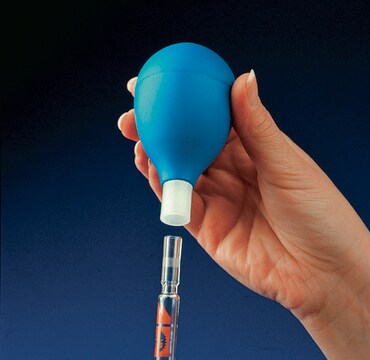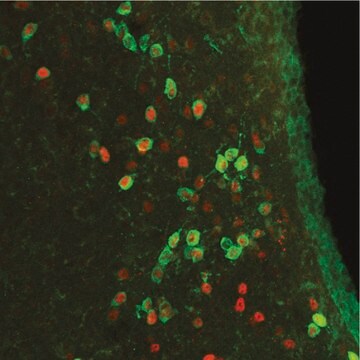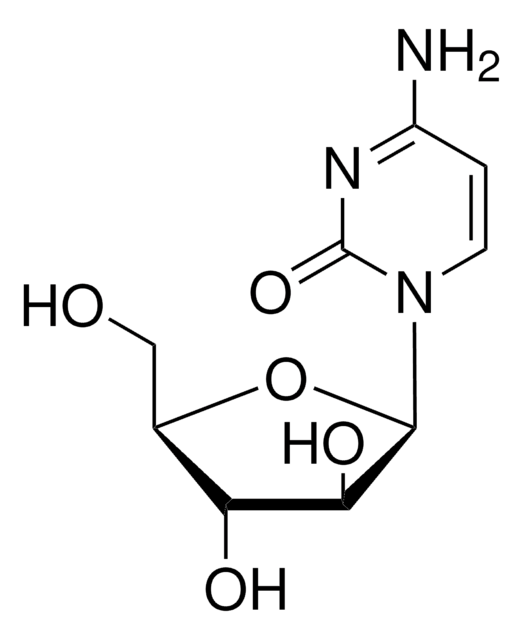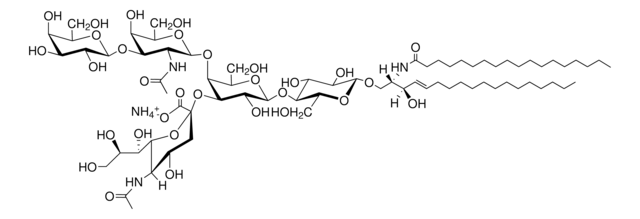推荐产品
生物源
mouse
品質等級
抗體表格
purified antibody
抗體產品種類
primary antibodies
無性繁殖
R24, monoclonal
物種活性
human, mouse, rat
技術
affinity binding assay: suitable
flow cytometry: suitable
immunohistochemistry (formalin-fixed, paraffin-embedded sections): suitable
immunoprecipitation (IP): suitable
western blot: suitable
同型
IgG3κ
運輸包裝
ambient
目標翻譯後修改
unmodified
基因資訊
human ... ST8SIA1(6489)
一般說明
Gangliosides are sialic acid-containing oligoglycosylceramides. They are classified based on the number of sialic acid residues per molecule. GM gangliosides contain one sialic acid residue, GD gangliosides contain two, GT contain three, and GQ contain four sialic acid residues. Sialyltransferase-catalyzed 2-3 sialylation of the galactose of the trisaccharide Gal 1-4Glc 1-1 Cer produces GM3, which can be further sialylated to produce GD3 with two sialic acid on the galactose. GD3 is found in melanocytes and other cells that originate in the neuroectoderm. It is expressed almost exclusively among gangliosides in the early stage of the brain development of mice and rats. It is also detected in the T cell malignant leukocytes, such as acute lymphoblastic leukemia cells, adult T cell leukemia cells, and in activated normal human T lymphocytes. GD3 is found in almost all melanomas and is considered as an important biomarker for malignant melanoma. GD3 positive cells show markedly increased cell growth and invasive characteristics. Suppression of GD3 expression with antisense GD3 synthase cDNA is shown to reduce tumor cell phenotypes such as growth, migration, metastasis, and angiogenesis in F11 cells. Intra-cytoplasmic domain of neogenin is reported to act as a driver to promote various cancer phenotypes. Ref.: Hamamura, K et al. (2005). Proc. Natl. Acad. Sci. USA. 102 (31), 11041 11046; Dippold, WG et al. (1985). Cancer Res. 45(8): 3699-3705; Kaneko, K et al (2016). J. Biol. Chem. (In press).
特異性
Clone R24 (a.k.a. R-24) immunostained neurites of cultured DRG neurons from wild-type, but not GD3 synthase-knockout, mice (Ribeiro-Resende, V.T., et al. (2014). PLoS One. 9(10):e108919).
Target glycolipid is not species-specific.
免疫原
SK-MEL-28 human melanoma cells (Dippold, W.G., et al. (1980). Proc. Natl. Acad. Sci. U.S.A. 77(10):6114-6118).
應用
Affects Function: A representative lot induced cellular Lyn kinase activity and tyrosine phosphorylation of cellular proteins of primary rat cerebellar cultures in a time-dependent manner (Kasahara, K., et al. (1997). J. Biol. Chem. 272(47):29947-29953).
Affinity Binding Assay: A representative lot reacted with heat stable glycolipid on the surface of all SK-MEL melanoma and two of the five astrocytoma cells tested, whereas epithelial cell types, fibroblasts, and cells of hematopoietic origin were found to lack the surface antigen recognized by clone R24 (Dippold, W.G., et al. (1980). Proc. Natl. Acad. Sci. U.S.A. 77(10):6114-6118).
Flow Cytometry Analysis: A representative lot immunostained the surface of cultured primary rat cerebellar cells (Kasahara, K., et al. (1997). J. Biol. Chem. 272(47):29947-29953).
Immunocytochemistry Analysis: A representative lot immunostained NGF-induced nurite outgrowths of cultured DRG neurons from wild-type, but not GD3 synthase-knockout, mice (Ribeiro-Resende, V.T., et al. (2014). PLoS One. 9(10):e108919).
Immunohistochemistry Analysis: A representative lot detected GD3 immunoreactivity in unfixed frozen tissue samples of primary melanoma and metastatic malignant melanoma (Dippold, W.G., et al. (1985). Cancer Res. 45(8):3699-3705).
Immunoprecipitation Analysis: A representative lot co-immunoprecipitated Lyn from rat brain membrane extract. Clone R24 co-immunoprecipitated caveolin and the exogenously expressed Lyn, but not Src, from CHO cells expressing exogenous GD3 synthase (Kasahara, K., et al. (1997). J. Biol. Chem. 272(47):29947-29953).
Affinity Binding Assay: A representative lot reacted with heat stable glycolipid on the surface of all SK-MEL melanoma and two of the five astrocytoma cells tested, whereas epithelial cell types, fibroblasts, and cells of hematopoietic origin were found to lack the surface antigen recognized by clone R24 (Dippold, W.G., et al. (1980). Proc. Natl. Acad. Sci. U.S.A. 77(10):6114-6118).
Flow Cytometry Analysis: A representative lot immunostained the surface of cultured primary rat cerebellar cells (Kasahara, K., et al. (1997). J. Biol. Chem. 272(47):29947-29953).
Immunocytochemistry Analysis: A representative lot immunostained NGF-induced nurite outgrowths of cultured DRG neurons from wild-type, but not GD3 synthase-knockout, mice (Ribeiro-Resende, V.T., et al. (2014). PLoS One. 9(10):e108919).
Immunohistochemistry Analysis: A representative lot detected GD3 immunoreactivity in unfixed frozen tissue samples of primary melanoma and metastatic malignant melanoma (Dippold, W.G., et al. (1985). Cancer Res. 45(8):3699-3705).
Immunoprecipitation Analysis: A representative lot co-immunoprecipitated Lyn from rat brain membrane extract. Clone R24 co-immunoprecipitated caveolin and the exogenously expressed Lyn, but not Src, from CHO cells expressing exogenous GD3 synthase (Kasahara, K., et al. (1997). J. Biol. Chem. 272(47):29947-29953).
Detect ganglioside GD3 using this mouse monoclonal Anti-Diasialoganglioside GD3, clone R24 Antibody, Cat. No. MABC1112, validated for use in Flow Cytometry and Immunocytochemistry, Western Blotting, Affects Function, Immunoprecipitation, Immunohistochemistry (Paraffin), Immunohistochemistry, Affinit
Research Category
Apoptosis & Cancer
Apoptosis & Cancer
品質
Evaluated by Flow Cytometry Analysis in SK-MEL-28 human skin melanoma cells.
Flow Cytometry Analysis: 0.2 µL of this antibody detected GD3 immunoreactivity on the surface of one million SK-MEL-28 human skin melanoma cells.
Flow Cytometry Analysis: 0.2 µL of this antibody detected GD3 immunoreactivity on the surface of one million SK-MEL-28 human skin melanoma cells.
外觀
Protein G purified
Format: Purified
Purified mouse monoclonal antibody IgG3 in PBS without azide.
儲存和穩定性
Stable for 1 year at -20°C from date of receipt.
Handling Recommendations: Upon receipt and prior to removing the cap, centrifuge the vial and gently mix the solution. Aliquot into microcentrifuge tubes and store at -20°C. Avoid repeated freeze/thaw cycles, which may damage IgG and affect product performance.
Handling Recommendations: Upon receipt and prior to removing the cap, centrifuge the vial and gently mix the solution. Aliquot into microcentrifuge tubes and store at -20°C. Avoid repeated freeze/thaw cycles, which may damage IgG and affect product performance.
其他說明
Concentration: Please refer to lot specific datasheet.
免責聲明
Unless otherwise stated in our catalog or other company documentation accompanying the product(s), our products are intended for research use only and are not to be used for any other purpose, which includes but is not limited to, unauthorized commercial uses, in vitro diagnostic uses, ex vivo or in vivo therapeutic uses or any type of consumption or application to humans or animals.
未找到合适的产品?
试试我们的产品选型工具.
儲存類別代碼
12 - Non Combustible Liquids
水污染物質分類(WGK)
WGK 2
閃點(°F)
Not applicable
閃點(°C)
Not applicable
我们的科学家团队拥有各种研究领域经验,包括生命科学、材料科学、化学合成、色谱、分析及许多其他领域.
联系技术服务部门






